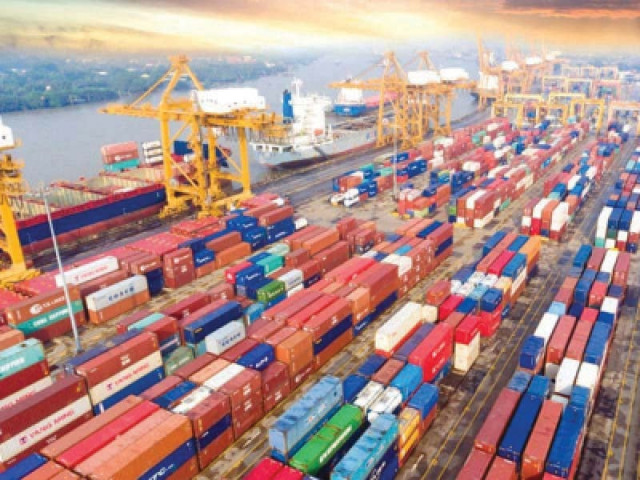Why is exporting goods so difficult?
Poor access to finance, excess regulations and bad taxation system are factors constraining export sector

A circular recently issued by the State Bank of Pakistan easing the import of raw material required by export-oriented industries from January 2, 2023, is finally a step in the right direction.
It won’t, however, solve the long-standing problems being faced by the industry over the past two decades; slow and low-level product diversification resulting in a stagnant trade-to-GDP ratio. Our export growth curve has been swinging at best – in contrast with good growth numbers posted by other SAARC (South Asian Association for Regional Cooperation) nations. Nearly 50% of our export dollars are earned from labour-intensive and light-manufacturing products which make our exports vulnerable to adverse external price shocks. This makes a case for our industry to explore niche products and shift from primary, low productivity and low-skilled goods to high-end goods.
This is the model that has been employed by rich countries across the world that have now managed to develop deep expertise in a few select industries. For example, Taiwan is the world’s leader in semi-conductor fabs while the United Kingdom (UK) boasts of high-quality financial consultancy services. When it comes to Pakistan, however, the only export industry (apart from Information-Technology (IT) services) that comes to mind is the low-end, low-tech textile industry.
It is high time that the body politics now make policy blueprints that incentivise the generation and production of new products with competitive and comparative advantage. Moreover, activities but not sectors, should be supported and every penny subsidised must be accounted for overall VfM (Value for Money) in dollars. For example, our fertiliser industry, though dependent on gas subsidies, has a huge competitive advantage in terms of price if exported. Capacity enhancement (to ensure surplus generation) and export restrictions, however, are hindering this billion-dollar industry.
Similarly, our IT industry, except for a few companies, is highly fragmented. We see many ERP (Enterprise Resource Planning) systems being designed and deployed at various places, but these efforts are made in silos, with no world-class, affordable, general-category ERP product that can be exported to the G20 countries.
This is where government needs to step in and negotiate technology transfer with the west along the same lines as China and the South-east Asian countries like Singapore. This should be followed by training programmes for prospective high-value added sectors upon adapting the foreign technology to Pakistan’s conditions.
The development of such niche products is not happening in Pakistan for several reasons including the government’s failure to identify market failures, lack of entrepreneurship and an artificially closed economy. With the present crisis of trade and current account deficits (CAD), the trade regime has become far more obstructive, unworkable and complex than it realistically should be.
For example, Pakistan trades more with the Gulf countries to use them as a re-export base for its products due to our restrictive trade policies. In fact, Pakistan is ranked at 170 when it comes to trade openness and our
economic policies have a clear anti-export bias. The various tariffs and custom duties have increased the cost of imported inputs which has tilted the balance in favour of import-substitution production. Exporters targeting the North American markets can’t pass the dead weight of import duties to foreign buyers if they want to stay competitive. Many exporters keep their export proceeds abroad in special duty-free zones of the United Arab Emirates (UAE) – with the aim of shifting production abroad in the long term.
Similarly, poor access to domestic finance, excess business regulations and a bad taxation system are other structural factors that constrain our export sector. For years, the government has been lending from commercial banks with little fiscal space left for medium-sized or even large exporters. This rent-seeking behaviour on the part of banks is something that the SBP should address on priority – ensuring that the ratio of the amount of loans taken by government are capped to that of the private sector. There is a dire need to develop new financial products, especially targeting Small and Medium sized Enterprises (SMEs), and to enforce transparency in the credit rating systems for access to loans as well as insurance services.
In a nutshell, it is time to re-evaluate our national export strategy to become sustainable and not just a short-term measure. Businessmen in legislative assemblies have shown a single-minded focus on boosting profits from their family-owned companies and rarely see the bigger picture due to inherent conflict of interest. This is where a stakeholder-oriented approach at the level of relevant standing committees in parliament is needed to seek fresh ideas from subject matter specialists, foreign experts, academia, and civil society at large. This is by no means an impossible task – though not an easy one.
THE WRITER IS A CAMBRIDGE GRADUATE AND IS WORKING AS A STRATEGY CONSULTANT



















COMMENTS
Comments are moderated and generally will be posted if they are on-topic and not abusive.
For more information, please see our Comments FAQ